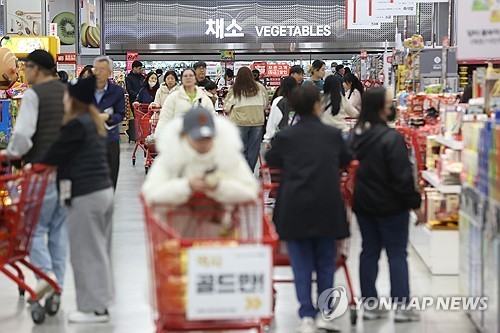- California Assembly OKs highest minimum wage in nation
- S. Korea unveils first graphic cigarette warnings
- US joins with South Korea, Japan in bid to deter North Korea
- LPGA golfer Chun In-gee finally back in action
- S. Korea won’t be top seed in final World Cup qualification round
- US men’s soccer misses 2nd straight Olympics
- US back on track in qualifying with 4-0 win over Guatemala
- High-intensity workout injuries spawn cottage industry
- CDC expands range of Zika mosquitoes into parts of Northeast
- Who knew? ‘The Walking Dead’ is helping families connect
Consumer prices rise 1.9 pct in May; fall below 2 pct for 1st time in 5 months
South Korea’s consumer prices grew at the 1 percent level for the first time in five months in May on falling oil prices, although a weaker local currency continued to raise the cost of imported goods, government data showed Wednesday.
Consumer prices, a key gauge of inflation, gained 1.9 percent from a year earlier last month, according to the data from Statistics Korea.
Consumer inflation had remained above the Bank of Korea’s 2 percent target for four consecutive months through April before slightly easing in May.
The statistics agency attributed the latest price increase to the depreciation of the local currency, which pushed up the costs of imported goods, notably processed food. Rising service prices also added upward pressure on overall inflation.

By sector, service prices increased 2.3 percent on-year, led by a 3.2 percent rise in dining-out expenses.
Processed food prices jumped 4.1 percent as major food producers passed on the higher costs of imported raw materials to consumers.
Agricultural, livestock and fishery product prices rose just 0.1 percent in May. This limited gain was largely due to a drop in vegetable prices, the agency said.
“The drop in agricultural prices was mainly due to increased vegetable shipments stemming from favorable weather conditions, as well as the high base effect from last year’s elevated fruit prices,” Lee Doo-won, a Statistics Korea official, said.
However, livestock prices jumped 6.2 percent in May, marking the sharpest on-year gain in 35 months since June 2022 when it recorded 9.5 percent on-year growth.
“Rising import prices for pork and a decline in cattle slaughter have pushed up beef prices. This, in turn, led to higher chicken prices as consumers turned to alternatives,” Lee said. “Egg prices also continued their upward trend in May after having rebounded in April.”
Petroleum product prices fell 2.3 percent, contributing to a 0.09 percentage point drop in the overall inflation rate.
The Korean won has come under sustained pressure amid heightened political uncertainty following President Yoon Suk Yeol’s brief imposition of martial law on Dec. 3. The situation was further exacerbated by U.S. President Donald Trump’s renewed tariff actions, raising concerns over potential impacts on South Korea’s export-driven economy.
Core inflation, which excludes volatile food and energy prices, rose 2 percent in May, slightly down from a 2.1 percent on-year increase in the previous month.












